Related Research Articles
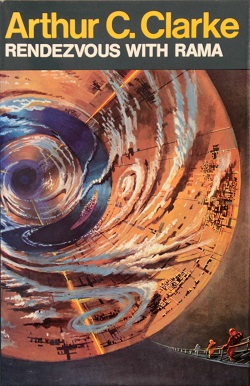
Rendezvous with Rama is a science fiction novel by British writer Arthur C. Clarke first published in 1973. Set in the 2130s, the story involves a 50-by-20-kilometre cylindrical alien starship that enters the Solar System. The story is told from the point of view of a group of human explorers who intercept the ship in an attempt to unlock its mysteries. The novel won both the Hugo and Nebula awards upon its release, and is regarded as one of the cornerstones in Clarke's bibliography. The concept was later extended with several sequels, written by Clarke and Gentry Lee.

The Fountains of Paradise is a 1979 science fiction novel by British writer Arthur C. Clarke. Set in the 22nd century, it describes the construction of a space elevator. This "orbital tower" is a giant structure rising from the ground and linking with a satellite in geostationary orbit at the height of approximately 36,000 kilometers. Such a structure would be used to raise payloads to orbit without the expense of using rockets. The novel won both the Hugo and Nebula Awards for Best Novel.
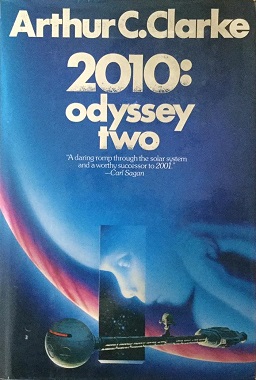
2010: Odyssey Two is a 1982 science fiction novel by British writer Arthur C. Clarke. It is the sequel to his 1968 novel 2001: A Space Odyssey, though Clarke changed some elements of the story to align with the film version of 2001.
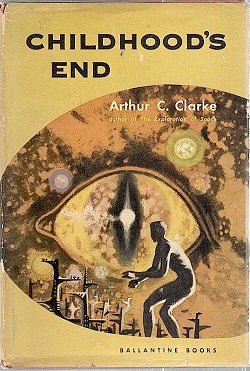
Childhood's End is a 1953 science fiction novel by the British author Arthur C. Clarke. The story follows the peaceful alien invasion of Earth by the mysterious Overlords, whose arrival begins decades of apparent utopia under indirect alien rule, at the cost of human identity and culture.

Earthlight is a science fiction novel by British writer Arthur C. Clarke, published in 1955. It is an expansion to novel length of a novella of the same name that he had published four years earlier.

Lucifer's Hammer is a science fiction post-apocalypse-survival novel by American writers Larry Niven and Jerry Pournelle that was first published in 1977. It was nominated for the Hugo Award for Best Novel in 1978. Two issues of a planned six-part comic book adaptation were published by Innovation Comics in 1993.

The Collected Stories of Arthur C. Clarke, first published in 2001, is a collection of almost all science fiction short stories written by Arthur C. Clarke. It includes 114 stories, arranged in order of publication, from "Travel by Wire!" in 1937 through to "Improving the Neighbourhood" in 1999. The story "Improving The Neighbourhood" has the distinction of being the first fiction published in the journal Nature. The titles "Venture to the Moon" and "The Other Side of the Sky" are not stories, but the titles of groups of six interconnected stories, each story with its own title. This collection is only missing a very few stories, for example "When the Twerms Came", which appears in his other collections More Than One Universe and The View from Serendip. This edition contains a foreword by Clarke written in 2000, where he speculates on the science fiction genre in relation to the concept of short stories. Furthermore, many of the stories have a short introduction about their publication history or literary nature.

Tales of Ten Worlds is a collection of science fiction short stories by British writer Arthur C. Clarke. The stories all originally appeared in a number of different publications.

The Hammer of God is a science fiction novel by Arthur C. Clarke originally published in 1993. Set in the year 2109, it deals with the discovery of an asteroid to be on course to collide with Earth and depicts the mission for deflecting the asteroid by using fusion thermal rockets.
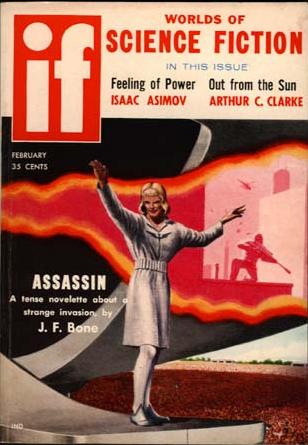
"The Feeling of Power" is a science fiction short story by American writer Isaac Asimov. The story first appeared in the February 1958 issue of If: Worlds of Science Fiction, and was reprinted in the 1959 collection Nine Tomorrows, the 1969 retrospective Opus 100, the 1970 anthology The Stars Around Us, and the 1986 collection Robot Dreams. In the introduction to Robot Visions, Asimov lists this story as one of the notable robot stories.

Islands in the Sky is a 1952 science fiction novel by British writer Arthur C. Clarke. It is one of his earliest works. Clarke wrote the story as a travelogue of human settlement of cislunar space in the last half of the twenty-first century.
"Sunjammer" is a science fiction short story by British writer Arthur C. Clarke, originally published in the March 1964 issue of Boys' Life,. The story has also been published under the title "The Wind from the Sun" in Clarke's 1972 collection of short stories with this title. It depicts a yacht race between solar sail spacecraft.
"Rescue Party" is a science fiction short story by English writer Arthur C. Clarke, first published in Astounding Science Fiction in May 1946. It was the first story that he sold, though not the first one published. It was republished in Clarke's second collection, Reach for Tomorrow (1956), and also appears in The Collected Stories of Arthur C. Clarke (2001).
Venture to the Moon is a group of six linked science fiction short stories by English writer Arthur C. Clarke. It was originally published in the British newspaper Evening Standard in 1956. The stories describe the first crewed mission to the Moon in 1975, as a joint American-Russian-British mission, and are narrated in first person from the point of view of the British team commander. Despite the death described in the third story, they are written in a humorous vein. They are collected in The Other Side of the Sky.

More Than One Universe: The Collected Stories of Arthur C. Clarke is a collection of science fiction short stories by Arthur C. Clarke originally published in 1991.

Sir Arthur Charles Clarke was an English science fiction writer, science writer, futurist, inventor, undersea explorer, and television series host.
The following is a list of works by Arthur C. Clarke.
"The Star" is an 1897 apocalyptic short story by H. G. Wells.
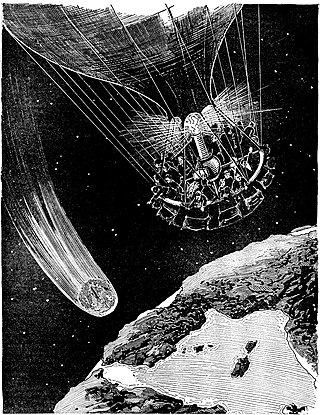
Comets have appeared in works of fiction since at least the 1830s. In keeping with their traditional cultural associations as omens, they often threaten destruction to Earth. This commonly comes in the form of looming impact events, and occasionally through more novel means such as affecting Earth's atmosphere in different ways. In other stories, humans seek out and visit comets for purposes of research or resource extraction. Comets are inhabited by various forms of life ranging from microbes to vampires in different depictions, and are themselves living beings in some stories.

Mother of Storms is a 1994 science fiction novel by American writer John Barnes. It was nominated for three major science fiction awards.
References
- Clarke, Arthur C. The Best of Arthur C Clarke; 1956 - 1972, published 1973